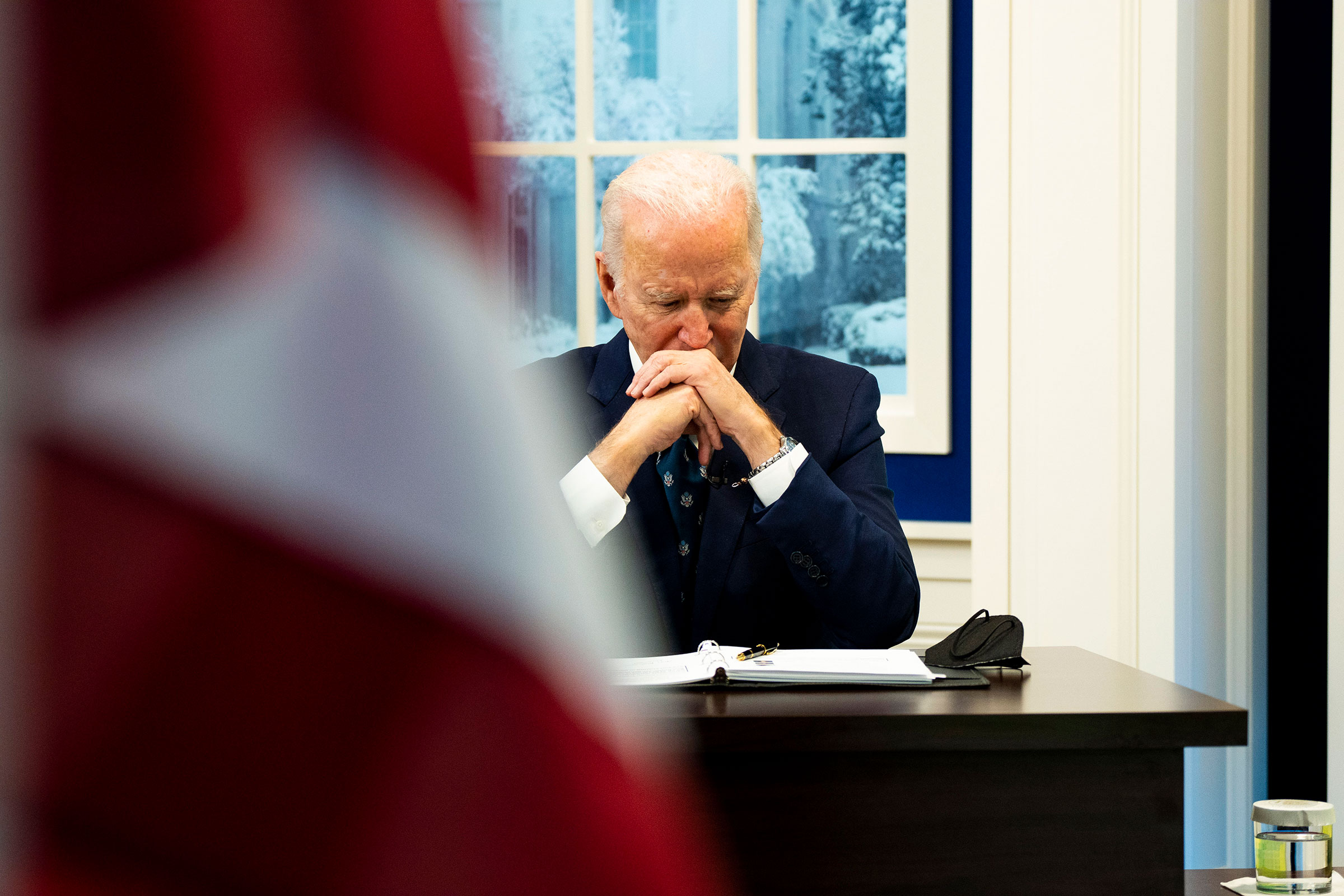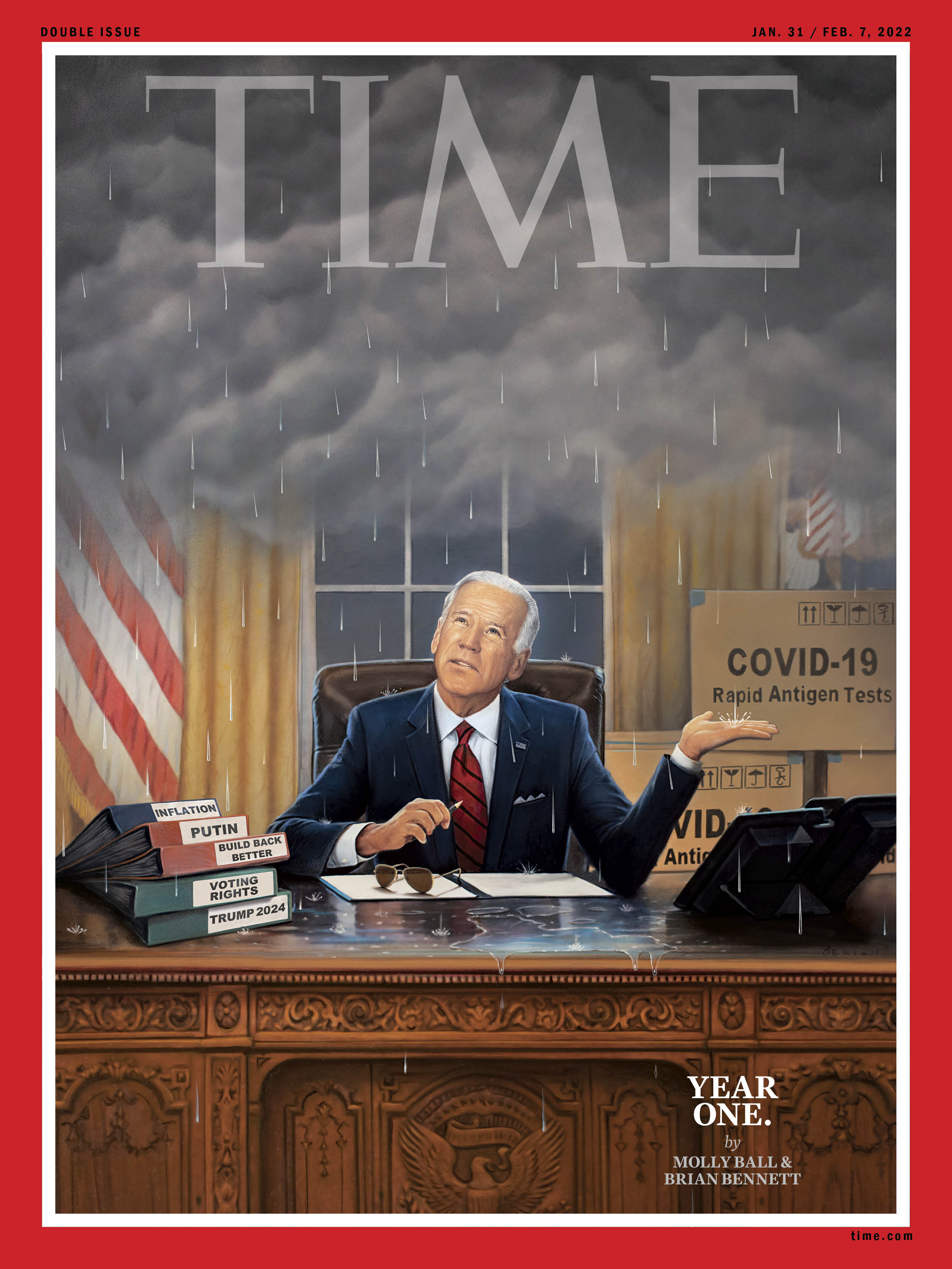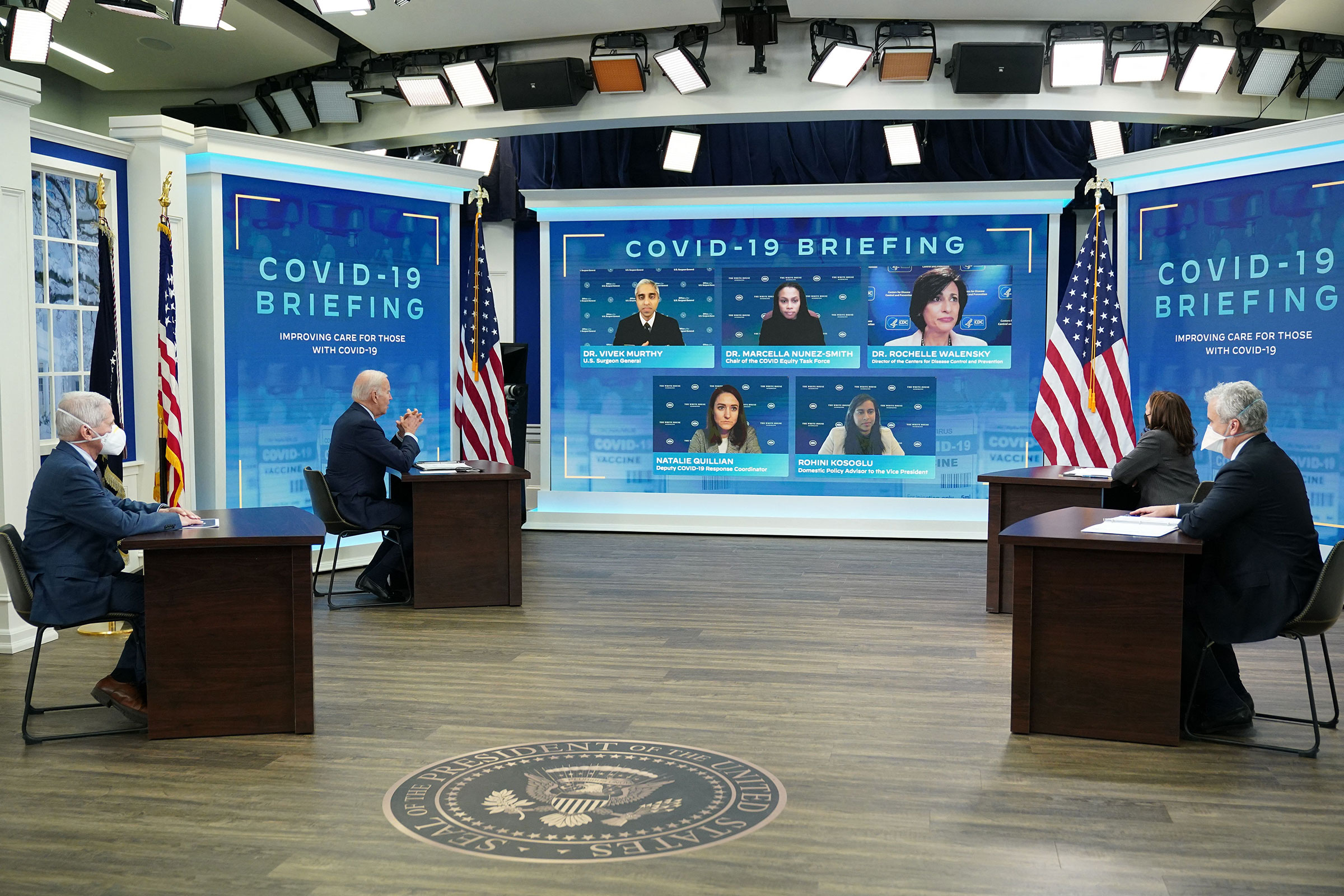
Last October, President Biden went to Capitol Hill to meet with the Democrats in the House of Representatives. Party members had been feuding over his proposed legislation, and leaders believed only the President could rally them together. Instead Biden stunned the caucus by sending them back to the drawing board. As he was leaving, a member approached him and pleaded, “Mr. President, we need a plan.” Biden didn’t answer, according to a source familiar with the exchange.
Three months later, the fate of Biden’s social-spending and climate package is more uncertain than ever. The pandemic he promised to bring to heel rages out of control. Inflation is at a four-decade high, canceling out rising wages. The border is a mess. Violent crime continues to climb. His approval rating has sunk to the low 40s. In the eyes of many Americans, “it’s just been one disappointment after another,” says Iowa-based nonpartisan pollster J. Ann Selzer. “Joe Biden was supposed to be the expert at dealing with all of these issues. What is it that he’s done right? Other than getting infrastructure passed, what has he done that’s come off really well?”
One year in, there’s a growing sense that the Biden presidency has lost its way. An Administration that pledged to restore competence and normalcy seems overmatched and reactive. Biden has been caught flat-footed by not one but two COVID-19 variants. He has repeatedly failed to close the deal with the Senate he boasted of mastering. The former chair of the foreign relations committee has presided over escalating tensions with Russia and China as well as a chaotic pullout from Afghanistan. The consequences to America’s credibility abroad could be lasting, says Ryan Crocker, former U.S. ambassador in Kabul. “What could be more damaging to internationalism in this country than an internationalist who is perceived as having just completely screwed the pooch?”
Defenders argue that Biden is managing as well as anyone could. Taking office in the shadow of Donald Trump and the Jan. 6 insurrection, he faces a country riven by pre-existing divisions and an opposition that views him as illegitimate. Biden racked up early successes rolling out vaccines and relief funds, they note, and hasn’t gotten sufficient credit for his bipartisan infrastructure bill. “For all this progress, I know there’s a lot of frustration and fatigue in this country,” Biden said of the pandemic at a Jan. 19 press conference, the second he has conducted on U.S. soil since being inaugurated. “We’ve been doing everything we can.”
Read More: It’s Shaping Up to Be a Tough 2022 for Joe Biden. Here Are His Biggest Challenges
Yet in a period of historic crisis, the President has been a shrinking figure, giving fewer interviews or press conferences than his predecessors. Voters widely question his capabilities. Privately, top Democrats acknowledge the public is losing faith in his leadership. “What people don’t see is an overarching plan,” a senior Administration official tells TIME.
One major party donor predicts a midterm wipeout. “When they f-cked up Afghanistan, they obliterated the competency thesis, and I don’t know how he comes back from that.” If you want a friend in Washington, get a dog, the old saying goes, but Biden can’t even get that right: Major, a rescued German shepherd featured in Biden’s campaign ads, was rehomed last month after injuring the President and biting two staffers.

If Biden had one job coming in, it was to get the pandemic under control. He campaigned on a plan to tackle the virus with sound science and serious policy rather than Trump’s denial and quackery. Upon taking office, he installed an experienced team and got vaccines out to millions of Americans in a matter of months.
But the pandemic response is now in a rough place. Omicron, while milder than previous variants, has sent cases surging. Hospitals are flooded, and businesses and schools struggle to remain open. In other countries, rapid tests have long been available free or cheap, but here they remain scarce and pricey. Data collection is a patchwork, leaving policymakers reliant on foreign sources for information.
Top scientists voice frustration. “The Administration has done really well on vaccines,” says Dr. Céline Gounder, an epidemiologist at New York University who advised Biden’s transition, “but the other interventions were more of an afterthought.”
Outside advisers presented a national testing proposal in early 2021, for example, and others regularly urged purchasing millions of rapid tests. But the White House remained fixated on the vaccination push. In May, the Centers for Disease Control and Prevention (CDC) announced that vaccinated people could stop wearing masks. In July, the President declared the U.S. had “gained the upper hand against this virus.”
Within weeks, the declaration of victory looked silly, as vaccinations plateaued and the Delta variant tore through the country. The Administration scrambled to change course, and “those challenges diverted attention from other, more long-range plans,” says Dr. Ezekiel Emanuel, another transition adviser, who recently helmed a public critique of the Administration’s COVID-19 response by a group of prominent scientists.
The Administration vowed to let scientists lead the way, but the result has been a confounding lack of coordination. The heads of the CDC, National Institutes of Health, Food and Drug Administration and the President’s COVID-19 task force have made conflicting statements on everything from boosters to quarantines, leaving the public befuddled and anxious. “I would argue that the American people have less trust in federal health officials now than a year ago,” says Dr. Leana Wen, a public health professor at George Washington University. In a CBS News poll released Jan. 16, two-thirds of Americans said the U.S. COVID-19 response was going badly.
Since the start of the pandemic, experts have emphasized high-quality masks, yet it took until Jan. 19 for the White House to announce it would begin providing them free to the public. On Jan. 18, the Administration unveiled a website that allows each household to order four free rapid tests. But they won’t ship until late January, after the Omicron wave has crested in many places. “It’s good that the Administration has finally responded to the loud voices of frustration,” Dr. Eric Topol, director and founder of the Scripps Research Translational Institute, wrote in December, “but it’s an exemplar of too little, too late.”
Read More: An N95 Is the Best Mask for Omicron. Here’s Why
Allies are perplexed that an experienced team has failed to prepare for foreseeable obstacles. White House COVID coordinator Jeffrey Zients is a former executive renowned for turning around troubled organizations. Biden’s chief of staff, Ron Klain, managed the Obama Administration’s successful response to the Ebola virus. And Dr. Anthony Fauci, Biden’s chief medical adviser, led the fight against HIV and AIDS. “Fauci knows the science, Zients knows management, and Klain knows pandemics,” says an operative close to the Administration. “You’d think if something was doable, they could do it. That’s the most vexing thing.”

Biden’s abilities to navigate Congress and bridge his party’s factions were major selling points of his campaign. The early returns were positive. In March, he signed the American Rescue Plan, a $1.9 trillion sequel to the multitrillion-dollar Trump-era COVID-19 relief bills that have together made America’s pandemic response one of the most generous in the world. Passed on a party-line vote, the legislation extended unemployment benefits; sent $1,400 checks to individuals; expanded food stamps, paid leave and tax credits for families; and provided billions in funding for local governments and health care. Biden also campaigned on a pledge to bring back bipartisanship, and that, too, seemed promising: in November, he signed a trillion-dollar infrastructure bill that got 19 Republican votes in the Senate, including that of GOP leader Mitch McConnell.
That legislation was supposed to be one major component of Biden’s ambitious domestic agenda. The other cornerstone would be Build Back Better, a mammoth social-spending bill originally priced at $3.5 trillion, with provisions addressing climate change, expanding Medicaid, providing childcare support and raising taxes on the rich. But two moderate Democrats, Joe Manchin of West Virginia and Kyrsten Sinema of Arizona, have stood in the way of the 50 Senate votes needed to pass it, and they have proved immune to Biden’s powers of persuasion. A source close to Manchin says the White House bungled the negotiations in December by failing to keep its commitments, leading him to announce his opposition. “They violated the deal he thought they had,” the source says.
Progressive Democrats who voted for infrastructure with the assurance that social spending would follow feel equally burned. Infighting has spilled into public view. “Our progress has ground to a halt because of the sabotaging of our agenda by Senator Manchin and Senator Sinema,” Senator Bernie Sanders tells TIME. The components of Build Back Better are consistently popular, but Republicans have paid no price for opposing it because the Democratic holdouts stand in the way, Sanders says.
Only Biden can bring the factions together. “The President understands that he is the only one that’s going to make this happen,” Representative Pramila Jayapal, who chairs the Congressional Progressive Caucus, tells TIME. “Because it was to him directly that Senator Manchin committed, and it was from him directly, to us and to the country, that he committed that he could get it done.”
Under pressure from civil rights activists and amid concern about Republican efforts to subvert elections, Biden decided to go to the mat on voting rights. In a fiery speech in advance of Martin Luther King Jr. Day, he dropped his longtime resistance to altering the Senate’s 60-vote filibuster threshold. But far from being pleased, leading Black organizations boycotted the speech. The Senate then planned a series of votes on the issue beginning Jan. 19, which were widely expected to fall short. The only result was likely to be a showcase of the President’s failure on an issue dear to his base.
Liberals and Black voters are naturally demoralized, says Maurice Mitchell, national director of the progressive Working Families Party. Biden “came in with a lot of fanfare about being this creature of the Senate who could play a unique role in cutting deals,” he says. “There are really big pieces of the President’s agenda that are still not settled, and it is really incumbent on him to seal the deal.”
Read More: Joe Biden Defended the Filibuster for Years. Now He Wants to End It for Voting Rights
Defenders say it’s unrealistic to expect too much with razor-thin congressional majorities, and complain that Biden hasn’t gotten enough credit for the things he’s accomplished. It may be premature to declare defeat on Build Back Better. “I think the jury’s still out on whether that effort is going to be successful,” says Democratic Senator Mark Warner.
But Democrats fear that a harsh political backlash looms. The President’s approval rating, historically an indicator of how his party will perform in November, is the worst at this stage of any modern presidency besides Trump’s. Only a quarter of Americans in the recent CBS poll thought things were going well, and majorities said Democrats were not focused enough on the economy and inflation. Republicans hold a slight lead in the generic congressional ballot for the first time in years; Gallup found a 14-point swing in party identification toward the GOP over the course of 2021. A raft of congressional Democrats have recently announced their retirements, fearful a wave is coming. “A lot of people have been very blunt with them about what a terrible job they’re doing,” a congressional Democrat says of the White House. “But they’re very sensitive.”
White House insiders describe a tight inner circle of longtime advisers to whom the President is loyal to a fault. “These are basically people who have been going to summer camp together since they were 5,” says the head of a prominent liberal organization. “The upside is that there’s not the same internal knifing you got in prior administrations, but it also means lots of blind spots.” A source who has known Biden for decades says, “It’s a team of competent, long-term staffers, and they’re behaving like that. It’s not a team of rivals with contending opinions.”
Voters hoped Biden would provide a sense of calm and steady leadership. But the reason he hasn’t been more visibly in charge is as much of an open secret as it is a taboo subject in Washington. The 79-year-old President has always been gaffe-prone, but in recent years his unsteadiness has become more pronounced. He tells stories that aren’t true, such as claiming to have been arrested in the civil rights movement, driven a tractor-trailer and intervened in Israel’s Six-Day War. In an August TV interview, he struggled to recall what branch of the military his late son Beau had served in and where he had been deployed. In a September meeting with Senators, he referred to himself as one of their colleagues before correcting himself: “Wait, wait, I’ve got this job now.” At the infrastructure signing ceremony, he bungled Sinema’s name.
Allies react angrily to the suggestion that the man with his finger on the nuclear button has lost a step, calling it a right-wing smear. (One senior official described Biden as having command of policy details in meetings.) But the perception is pervasive. A Jan. 19 Politico poll found 49% of voters doubted Biden’s mental fitness. Large majorities did not consider him “energetic” or a “strong leader.” In an October Harvard-Harris poll, 58% said he was too old to be President.
In one recent focus group of swing voters conducted by a liberal organization and observed by TIME, a Biden voter from Milwaukee said, “I question his competency because of his age. I don’t think he’s in a position to run this country.” In a separate session, a Biden voter from Kentucky said, “I had high hopes for him in the beginning, but he seems more and more not in control. You see him walk around, he kind of shuffles, like a great-grandparent. He just is not that sharp.”
Many Democrats argue that Biden’s low ratings stem from factors beyond his control. He inherited a mess, they note, and has gotten little help from a Republican Party dangerously fixated on conspiracy theories about vaccines and the 2020 election. “The pandemic has created a sense that things are not where people want them to be, and they’re sad about the continuing divisions and disruptions,” says Democratic pollster Margie Omero. “That continues because of the Republicans—it’s not something Biden can change.” Biden, too, doesn’t think the polling is a reflection of how he’s done his job. “I have probably outperformed what anybody thought would happen,” he said at the Jan. 19 press conference.
Inside the White House, there’s a belief that the press is overly negative, though if anything Biden has benefited with voters and the media alike from the low bar set by Trump. (Given five days’ notice, the Administration declined to make a senior official available to speak on the record for this article, saying the long holiday weekend made scheduling difficult.) Allies who acknowledge change is needed advise the President to be more visible, project strength and pivot away from congressional chaos, deploying the Vice President and Cabinet to sell his policies. “He needs to make the case more forcefully and get more folks out there making the case,” says Rodell Mollineau, an adviser to Biden’s Unite the Country super PAC. “It’s now an election year, and you need to convince the American people that we have made some progress.”
On Jan. 13, Biden returned to Capitol Hill, this time to make a show of strong-arming his party’s Senators to pass voting legislation. But the gambit broadcast weakness instead. Just before he arrived, Sinema blindsided him with a floor speech blasting the idea. In the meeting itself, Biden spent several minutes reminiscing about the days of Robert Byrd and Strom Thurmond, Senators reported afterward. Sinema did not speak up in the meeting, and Biden did not call on her to explain herself. One Senator told TIME the President was “soft-spoken” and difficult to hear. Immediately afterward, Manchin reaffirmed his opposition as well.
In the Capitol, reporters clustered around Biden, seeking his perspective on the way forward—a plan. He offered only a shrug. “I hope we can get this done,” the President said. “But I’m not sure.”
—With reporting by Abigail Abrams, Leslie Dickstein, W.J. Hennigan, Nik Popli, Abby Vesoulis and Julia Zorthian
More Must-Reads From TIME
- The 100 Most Influential People of 2024
- How Far Trump Would Go
- Scenes From Pro-Palestinian Encampments Across U.S. Universities
- Saving Seconds Is Better Than Hours
- Why Your Breakfast Should Start with a Vegetable
- 6 Compliments That Land Every Time
- Welcome to the Golden Age of Ryan Gosling
- Want Weekly Recs on What to Watch, Read, and More? Sign Up for Worth Your Time
Write to Molly Ball at molly.ball@time.com